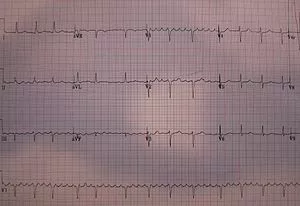Arrhythmias, or irregular heartbeats, are a common health concern affecting millions of people worldwide. They can range from harmless to life-threatening, making it crucial to understand the most common types, their causes, symptoms, and treatment options. In this comprehensive guide, we delve into the world of arrhythmias to provide a deeper insight into these heart rhythm disorders.
What Are Arrhythmias?
Arrhythmias are abnormalities in the rhythm of the heartbeat. Normally, the heart contracts and relaxes in a regular pattern, allowing it to pump blood effectively throughout the body. However, in individuals with arrhythmias, this rhythm is disrupted, leading to irregular heartbeats that can be too slow (bradycardia), too fast (tachycardia), or irregular in rhythm (atrial fibrillation).
SEE ALSO: What Is Your Heart Rate with AFib And How to Manage It
The Most Common Arrhythmias
1. Atrial Fibrillation (AFib)
AFib is one of the most prevalent types of arrhythmias, characterized by rapid and irregular heartbeats originating in the atria, the upper chambers of the heart.
Causes and Risk Factors: AFib can be caused by various factors, including high blood pressure, heart disease, obesity, and advanced age. It is more common in older adults and those with preexisting heart conditions.
Symptoms: Symptoms of AFib may include palpitations, fatigue, shortness of breath, dizziness, and chest discomfort.
Treatment Options: Treatment for AFib aims to control heart rate, restore normal rhythm through medications or procedures like cardioversion, and reduce the risk of complications such as stroke with anticoagulant medications.
2. Atrial Flutter
Atrial flutter is similar to AFib but involves a more organized, rapid heartbeat originating from the atria.
Causes and Risk Factors: Like AFib, atrial flutter can be caused by underlying heart conditions, electrolyte imbalances, and other factors.
Symptoms: Symptoms may include palpitations, chest pain, shortness of breath, and fatigue.
Treatment: Treatment may involve medications to control heart rate and rhythm, cardioversion, and addressing underlying causes.
3. Ventricular Tachycardia (VT)
VT is a rapid heartbeat originating in the ventricles, the lower chambers of the heart. It can be life-threatening if not promptly treated.
Causes: VT can result from heart disease, previous heart attacks, electrolyte imbalances, or certain medications.
Symptoms: Symptoms of VT may include palpitations, dizziness, lightheadedness, fainting, and cardiac arrest in severe cases.
Emergency Treatment: Immediate medical intervention is required for VT, often involving cardioversion, medications, or implantable devices like defibrillators to restore normal heart rhythm.
4. Ventricular Fibrillation (VF)
VF is a serious arrhythmia where the ventricles quiver instead of contracting effectively, leading to a rapid and chaotic heartbeat.
Causes and Risk Factors: VF is commonly associated with underlying heart disease, heart attacks, electrolyte imbalances, and sudden cardiac events.
Symptoms: VF presents as sudden loss of consciousness, no pulse, and cessation of breathing, requiring immediate medical attention and cardiopulmonary resuscitation (CPR) measures.
Treatment: Treatment involves rapid defibrillation to restore normal heart rhythm, along with addressing underlying cardiac conditions.
SEE ALSO:What Triggers AFib During Sleep?
Diagnosis And Management
Diagnosing arrhythmias involves a combination of medical history review, physical exams, electrocardiograms (ECGs or EKGs), Holter monitoring, event recorders, and electrophysiology studies. Once diagnosed, management strategies may include:
Lifestyle Modifications: Adopting a heart-healthy lifestyle with regular exercise, balanced diet, weight management, and smoking cessation can reduce the risk and severity of arrhythmias.
Medications: Antiarrhythmic medications, beta-blockers, calcium channel blockers, and anticoagulants may be prescribed to control heart rate, rhythm, and reduce the risk of complications.
Cardioversion: Electrical cardioversion or pharmacological cardioversion may be performed to restore normal heart rhythm in certain arrhythmias.
Catheter Ablation: This procedure involves using radiofrequency energy or cryotherapy to destroy abnormal heart tissue causing arrhythmias, particularly useful in cases of atrial fibrillation and flutter.
Implantable Devices: Pacemakers and implantable cardioverter-defibrillators (ICDs) are used to regulate heart rhythm and deliver therapeutic shocks if needed.
Conclusion
Arrhythmias are a diverse group of heart rhythm disorders that can significantly impact quality of life and cardiovascular health. Understanding the common types of arrhythmias, their causes, symptoms, and management options is essential for both patients and healthcare providers in providing timely and effective care for these conditions. With advancements in diagnosis and treatment, individuals with arrhythmias can lead fulfilling lives with appropriate medical management and lifestyle modifications.

